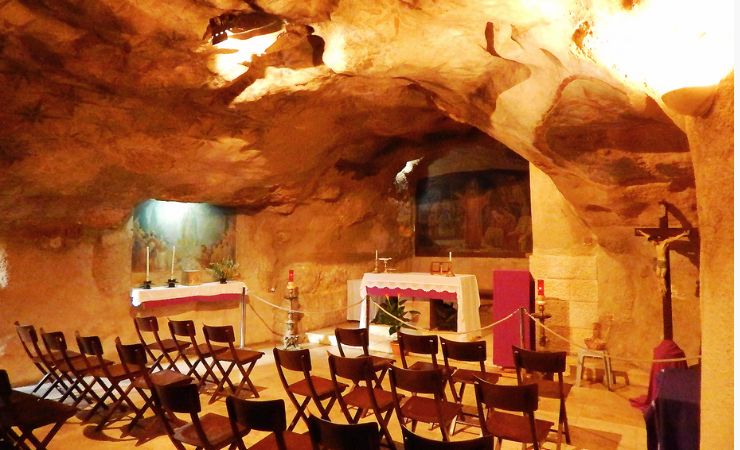Grotto of Gethsemane: Where Christ confronts his Deepest Fears
At the Grotto of Gethsemane (or the Grotto of the Betrayal) amidst the ancient olive trees, Jesus Christ confronted his deepest fears and made peace with his fate. The place has been a pilgrimage site for devout Christians since the 4th century.

Location
Situated at the foot of the Mount of Olives in Jerusalem, the Grotto of Gethsemane lies adjacent to the renowned Garden of Gethsemane and a few meters away from the Tomb of Virgin Mary.
Biblical context
The New Testament recounts that Jesus often retreated to Gethsemane with his disciples. It was in this very garden that he experienced profound anguish the night before his crucifixion. According to the Gospels, Jesus prayed fervently, grappling with the weight of his impending sacrifice. The Gospel of Luke describes his distress.
This intense moment of reflection and prayer was abruptly interrupted by the betrayal of Judas Iscariot, leading to Jesus’s arrest.



The History of the Grotto of Gethsemane
The Grotto of Gethsemane is traditionally identified as the spot where Jesus sought solace in prayer on the eve of his crucifixion. According to tradition, while Jesus prayed, his disciples found rest within this cave. It was here that Judas, with a betraying kiss, marked Jesus for arrest.
This natural cave, about 190 meters in size, once served farmers as a storage for grains. In the early centuries, the betrayal’s location was believed to be a stone to the left of the pathway connecting Jerusalem to the Mount of Olives. However, for almost a millennium, this cave was recognized as the betrayal’s backdrop. By the 6th century, certain Christian sects viewed it as a cenacle. In 1333, German Dominican Wilhelm von Boldensele identified the cave as the site of Christ’s agony, leading to its renaming as the Grotto of the Agony.
Presently, the consensus is that Jesus’s agony unfolded in the Garden of Gethsemane, while the betrayal transpired in the grotto. The notion of the Last Supper occurring here persisted until the 15th century but eventually faded.
Ownership of the the Grotto of Gethsemane transitioned to the Franciscans in the 17th century (they lost ownership from the Virgin Mary’s Tomb nearby). Eastern Orthodox Christians once utilized the cave but relinquished their land rights in 1919. Today, the Franciscans oversee the site. After 1955’s flood wreaked havoc the cave was renovated, and the original entrance sealed, making way to a new, flood-resistant one.
Despite the 1955 renovations, the grotto retains an aura reminiscent of its state two millennia ago.
Grotto of Gethsemane Artifacts
-
The alters: The Grotto of Gethsemane boasts three alters with murals. Above the primary altar, there’s an artistic portrayal of Jesus in prayer amidst the Apostles. The side altars, on the other hand, showcase paintings of the Virgin’s Assumption and Judas’ treacherous kiss. A bronze statues beneath the main altar illustrate two disciples asleep.
-
To the right of one altar, a hole in the wall stands at the perfect height to support a wooden beam. This beam, when weighed down at its other end, would press crushed olives stacked in woven baskets.
- The ceiling of the cave consists of artwork of stars signifying where Jesus preyed under a stary night.
-
Wall inscriptions are prone to interpretations. One line encircling the sanctuary likely translates to: “Here, the King shed tears of blood. Christ the Redeemer often visited this spot with his apostles. My Father, if you will it, spare me this cup.”
Sources and Additional Reading
See the Holyland – Gethsemane
Showcaves – Grotto of Gethsemane
Nearby Sites
- Church of All Nations: Built over the “Rock of the Agony,” this church is a significant landmark that commemorates Jesus’s prayer in the garden before his arrest.
- Tomb of the Virgin Mary: This site is revered by the Eastern Orthodox Church and the Armenian Church as the burial place of the Virgin Mary.
- The Tomb of the Kidron Valley: The Kidron Valley is dotted with ancient tombs and burial monuments such as the Tomb of Absalom, Zechariah, and Tomb of Benei Hezir.
- Church of Mary Magdalene: A beautiful Russian Orthodox church situated next to an orchard, offering a different perspective on the biblical narrative.



